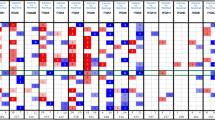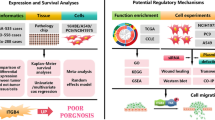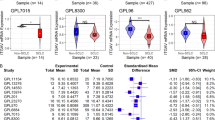Abstract
Objective
To study integrin α6 expression in lung adenocarcinoma tissue through comparison with matching adjacent non-cancerous tissues as well as elucidating the correlation between integrin α6 expression with the clinical parameters of lung adenocarcinoma. We also explore the signal pathways associated with integrin α6 up-regulation.
Methods
The clinical data, cancer tissues, and adjacent non-cancerous tissues of 30 patients diagnosed with lung adenocarcinoma were collected from Taizhou Hospital in Zhejiang Province, China, in 2010. The protein levels of integrin α6 were determined by immunohistochemistry methods. mRNA data of 85 lung adenocarcinoma tissues and 14 normal tissues as well as clinical results were collected from GEO30219. We also collected mRNA data of 533 lung adenocarcinoma tissues and 59 normal tissues as well as the clinical results of 522 patients with lung adenocarcinoma from the Cancer Genome Atlas (TCGA) database. The differences in protein and mRNA levels in cancer tissues and non-cancerous tissues were analyzed, and we subsequently investigated the association between integrin α6 expression and key parameters indicating lung adenocarcinoma progression and overall survival rate. Additionally, the possible pathways involved in the up-regulation of integrin α6 were analyzed by GSEA.
Results
The protein levels of integrin α6 in lung adenocarcinoma tissues were significantly higher than those in adjacent tissues (p < 0.01), and were positively correlated with the grade and T stage of lung adenocarcinoma (p < 0.05). Patients with low integrin α6 protein levels had higher survival rates (p < 0.05). The analysis of gene chip data from the TCGA database also showed that the integrin α6 mRNA level was significantly correlated with T stage (p < 0.05), overall survival (OS) rate (p < 0.01), and disease-free survival (DFS) rate (p = 0.005). GSEA gene enrichment analysis identified a series of pathways that may be associated with integrin α6 up-regulation, including the AGR, PYK2, ECM, and PTEN pathways.
Conclusion
Integrin α6 plays an important role in the occurrence and progression of lung adenocarcinoma and may act as a prognostic predictor of lung adenocarcinoma in patients. Based on the results of the present study, integrin α6 may be a potential target gene for the treatment of lung adenocarcinoma.








Similar content being viewed by others
References
Acosta D, Suzuki M, Connolly D, Thompson RF, Fazzari MJ, Greally JM, Montagna C (2011) DNA methylation changes in murine breast adenocarcinomas allow the identification of candidate genes for human breast carcinogenesis. Mamm Genome 22:249–259
Bachelder RE, Ribick MJ, Marchetti A, Falcioni R, Soddu S, Davis KR, Mercurio AM (1999) P53 inhibits α6β4 integrin survival signaling by promoting the caspase 3–dependent cleavage of Akt/PKB. J Cell Biol 147:1063–1072
Bartolazzi A, Cerboni C, Flamini G, Bigotti A, Lauriola L, Natali PG (2010) Expression of alpha 3 beta 1 integrin receptor and its ligands in human lung tumors. Int J Cancer 64:248–252
Beer DG et al (2002) Gene-expression profiles predict survival of patients with lung adenocarcinoma. Nat Med 8:816–824
Bhattacharjee A, Meyerson M (2001) Classification of human lung carcinomas by mRNA expression profiling. Proc Natl Acad Sci USA 98:13790–13795
Bi L, Yan X, Yang Y, Qian L, Tian Y, Mao JH, Chen W (2017) The component formula of Salvia miltiorrhiza and Panax ginseng induces apoptosis and inhibits cell invasion and migration through targeting PTEN in lung cancer cells. Oncotarget 8:101599–101613
Camilleri AA, Willmann R, Sadasivam G, Lin S, Rüegg MA, Gesemann M, Fuhrer C (2007) Tyrosine phosphatases such as SHP-2 act in a balance with Src-family kinases in stabilization of postsynaptic clusters of acetylcholine receptors. BMC Neurosci 8(1):46
Chen W et al (2016) Cancer statistics in China, 2015. CA Cancer J Clin 66:115–132
Frans H, Ingrid K, Geurts KA, Arnoud S (1991) Molecular cloning of the human α6 integrin subunit. FEBS J 199:425–433
Friedrichs K, Ruiz P, Franke F, Gille I, Terpe HJ, Imhof BA (1995) High expression level of α6 integrin in human breast carcinoma is correlated with reduced survival. Cancer Res 55:901–906
Guo W, Giancotti FG (2004) Integrin signalling during tumour progression. Nat Rev Mol Cell Biol 5:816–826
Howlader N et al (2014) SEER cancer statistics review, 1975–2011. Available from: http://seer.cancer.gov/csr/1975_2011/
Hsu YL, Wu CY, Hung JY, Lin YS, Huang MS, Kuo PL (2013) Galectin-1 promotes lung cancer tumor metastasis by potentiating integrin α6β4 and Notch1/Jagged2 signaling pathway. Carcinogenesis 34:1370–1381
Huttenlocher A, Lakonishok M, Kinder M, Wu S, Truong T, Knudsen KA, Horwitz AF (1998) Integrin and cadherin synergy regulates contact inhibition of migration and motile activity. J Cell Biol 141:515–526
Isaac J, Ying WL, Tarapore P, Ho S (2012) Abstract B48: integrin α6 S-nitrosylation induces prostate cancer cell migration by loss of adhesion to laminin-1. Cancer Res 72:B48–B48
Jandova J, Mason CJ, Pawar SC, Watts GS (2015) Fn14 receptor promotes invasive potential and metastatic capacity of non-small lung adenocarcinoma cells through the up-regulation of integrin α6. Neoplasma 62:41–52
Larsen JE, Pavey SJ, Passmore LH, Bowman RV, Hayward NK, Fong KM (2007) Gene expression signature predicts recurrence in lung adenocarcinoma. Clin Cancer Res 13:2946–2954
Li DM, Sun H (1997) TEP1, encoded by a candidate tumor suppressor locus, is a novel protein tyrosine phosphatase regulated by transforming growth factor beta. Cancer Res 57:2124–2129
Li X et al (2016) Triptolide reduces proliferation and enhances apoptosis of human non-small cell lung cancer cells through PTEN by targeting miR-21. Mol Med Rep 13:2763–2768
Lynch TJ et al (2004) Activating mutations in the epidermal growth factor receptor underlying responsiveness of non-small-cell lung cancer to gefitinib. N Engl J Med 350:2129–2139
Mainiero F et al (2014) The coupling of alpha6beta4 integrin to Ras-MAP kinase pathways mediated by Shc controls keratinocyte proliferation. EMBO J 16:2365–2375
Nikolopoulos SN, Blaikie P, Yoshioka T, Guo W, Puri C, Tacchetti C, Giancotti FG (2005) Targeted deletion of the integrin beta4 signaling domain suppresses laminin-5-dependent nuclear entry of mitogen-activated protein kinases and NF-kappaB, causing defects in epidermal growth and migration. Mol Cell Biol 25:6090–6102
Oshita F et al (2002) Increased expression of integrin beta1 is a poor prognostic factor in small-cell lung cancer. Anticancer Res 22:1065–1070
Sacchi A, Falcioni R, Piaggio G, Gianfelice MA, Perrotti N, Kennel SJ (1989) Ligand-induced phosphorylation of a murine tumor surface protein (TSP-180) associated with metastatic phenotype. Cancer Res 49:2615
Shaw AT et al (2013) Crizotinib versus chemotherapy in advanced ALK-positive lung cancer. N Engl J Med 368:2385–2394
Stevens LE et al (2017) Extracellular matrix receptor expression in subtypes of lung adenocarcinoma potentiates outgrowth of micrometastases. Can Res 77:1905
Stewart RL, O’Connor KL (2015) Clinical significance of the integrin α6β4 in human malignancies. Lab Investig J Tech Methods Pathol 95:976–986
Stewart RL et al (2016) Elevated integrin α6β4 expression is associated with venous invasion and decreased overall survival in non-small cell lung cancer. Hum Pathol 54:174–183
Takenaka K, Shibuya M, Takeda Y, Hibino S, Gemma A, Ono Y, Kudoh S (2001) Altered expression and function of β1 integrins in a highly metastatic human adenocarcinoma cell line. Int J Oncol 17:1187–1194
Takeyama H, Funahashi H, Sawai H, Takahashi H, Yamamotorm M, Akamo Y, Manabe T (2007) Expression of alpha6 integrin subunit is associated with malignancy in gastric gastrointestinal stromal tumors. Med Sci Monit Int Med Jo Exp Clin Res 13:CR51
Tang JM, He QY, Guo RX, Chang XJ (2006) Phosphorylated Akt overexpression and loss of PTEN expression in non-small cell lung cancer confers poor prognosis. Lung Cancer 51:181–191
Toh CK et al (2006) Never-smokers with lung cancer: epidemiologic evidence of a distinct disease entity. J Clin Oncol 24:2245–2251
Trinidad JC, Fischbach GD, Cohen JB (2000) The Agrin/MuSK signaling pathway is spatially segregated from the neuregulin/ErbB receptor signaling pathway at the neuromuscular junction. J Neurosci Off J Soc Neurosci 20:8762
Wan J, Che Y, Kang NN, Chai HP (2015) SOCS3 may regulate HIF-1α expression and cell proliferation by mediating PYK2 signaling pathways in the small cell lung cancer cell line. Oncol Prog 1:79–83
Weinel RJ, Rosendahl A, Neumann K, Chaloupka B, Erb D, Rothmund M, Santoso S (2010) Expression and function of VLA-α2, -α3, -α5 and -α6-integrin receptors in pancreatic carcinoma. Int J Cancer 52:827–833
Xia M, Tong JH, Ji NN, Duan ML, Tan YH, Xu JG (2016) Tramadol regulates proliferation, migration and invasion via PTEN/PI3K/AKT signaling in lung adenocarcinoma cells. Eur Rev Med Pharmacol Sci 20:2573
Funding
This study was funded by Zhejiang Provincial Natural Fund (The Mechanism of Integrin Mediated Wnt/β-catenin Signaling Pathway in Regulating Lymphangiogenesis in Lung Cancer) (grant number LQ18H160029).
Author information
Authors and Affiliations
Corresponding authors
Ethics declarations
Conflict of interest
None of the authors have any conflict of interest to declare.
Patient study
The study has been approved by the ethics committee and patients gave their informed consent before material was obtained for use in the study.
Additional information
Publisher's Note
Springer Nature remains neutral with regard to jurisdictional claims in published maps and institutional affiliations.
Rights and permissions
About this article
Cite this article
Shen, J., Xu, J., Chen, B. et al. Elevated integrin α6 expression is involved in the occurrence and development of lung adenocarcinoma, and predicts a poor prognosis: a study based on immunohistochemical analysis and bioinformatics. J Cancer Res Clin Oncol 145, 1681–1693 (2019). https://doi.org/10.1007/s00432-019-02907-1
Received:
Accepted:
Published:
Issue Date:
DOI: https://doi.org/10.1007/s00432-019-02907-1




